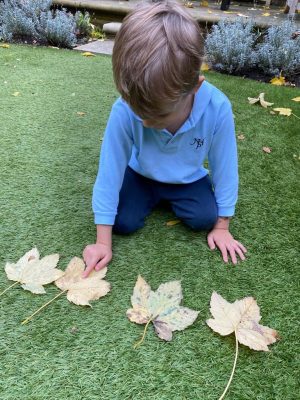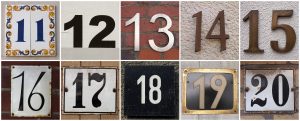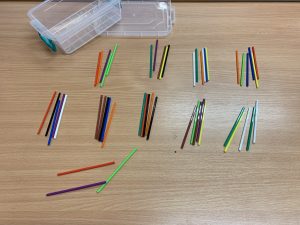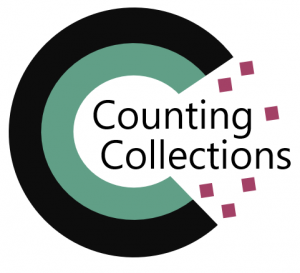
February 20, 2023, by Rupert Knight
Counting Collections: the importance of manipulating objects in early number learning
In this blog post Catherine Gripton explores the importance of ‘hands on’ experiences for early number learning and ‘Counting Collections’ as a systematic approach to provide them.
Learning to count is complex, requiring regular practice over time
Learning to count to 20 takes children approximately four years (primarily between the ages of 2 and 6). In this time, children learn the number words, numeral symbols, counting sequence, to count each item once and the meaning of each number (how many). They learn how number words are used (e.g. that any of the items can be tagged as ‘one’ but after that no other item can be ‘one’ in that count because it has been used) and the relative magnitude of numbers (e.g. that five is more than three). In English, unlike some other languages, the number words to 20 are difficult to learn. 11-19 don’t follow a logical pattern, with 11 and 12 having their own names and 13-19 being constituted of a version of 3-9 with a version of ten (teen) but the opposite way around to how they are written (e.g. thirteen is ‘three-ten’ which sounds like 30 rather than 13).

set of house numbers from 11 to 20
Over time, children need frequent opportunities to count, regularly practising and familiarising themselves with all the elements that are required for accurate counting. This is more than verbalising the number sequence (learning the ‘song’) or learning numeral names. It is developing number sense, involving connecting numbers, words, symbol and quantity as well as comparison, composition, multiple representations and number patterns.
Last year UCL published research into maths apps for children in the first few years of school, finding that 83% of the apps they reviewed focussed on number. Whilst some learning gains can be achieved counting on screens, it is important that children still have lots of experience counting objects. ‘Hands on’ manipulation of objects supports mathematical thinking as children move to count, organise, group and arrange objects. There is a substantial amount of research into the importance of manipulatives for early number learning. These can be any item that children can handle and move, ranging from shells, toys and pennies to cubes, rods and counters.

Some children are disadvantaged by having fewer counting experiences than their peers
Children learn to count through experience where frequent opportunities to count support this essential learning. Children at an earlier stage of development are often less experienced with number. This can be compounded by them probably being less attentive to number in their everyday experiences and play. The more number-experienced children are continuing to reinforce and develop their number skills spontaneously, whilst their less number-experienced peers may not. As parents/carers and teachers, we can provide frequent opportunities to count in an effort to counteract disparities in children’s number experiences.

In schools, this means being systematic so children with fewer number experiences don’t accidentally miss out on regular counting experiences. It also means providing environments which are rich in counting opportunities to increase the frequency of counting. One approach is to introduce the opportunity to count for the simple joy of counting. This can be achieved by having varied and interesting items available for counting and modelling interest in choosing and counting these items. This can encourage children to have favourite things to count so that, just like children can read and reread a favourite book over and over again, children can count and recount a favourite collection time and time again.
The potential of Counting Collections for improving number learning in Reception classes
In a number of countries, including Australia and the United States, counting bags or boxes of manipulatives have been used in a ‘hands on’ approach to number learning known as ‘counting collections’. This is typically with classes of primary-aged children and involves paired counting of collections of objects with the teacher facilitating and suggesting or modelling methods.
Recently, the University of Nottingham has developed a Counting Collections programme which uses these ideas with younger children. It includes professional development sessions and materials to support teachers, as well as carefully selected manipulatives (objects for counting), based upon previous research by Gripton & Pawluch (2021).

Our Counting Collections approach supports counting; subitising; comparing numbers and composing/decomposing numbers, as well as estimation; representation and understanding numerals. The children work in pairs to select a box of objects (manipulatives) from a counting library (set of differently sized collections in boxes) and set out to find how many are in the box. They can access ten frames, pots and other tools to assist with counting and then record their count on paper using mark-making and symbols as appropriate. Collection sizes are increased over time alongside teaching of more complex strategies including counting in groups such as 2s, 5s or 10s. The Counting Collections programme from the University of Nottingham includes the resources (counting library and tools) and professional development for teachers to enhance subject knowledge and training for how to use Counting Collections in maths sessions and during child-initiated play.
New Education Endowment Foundation trial: get involved!
For the school year 2023-24, the Education Endowment Foundation (EEF) is funding a trial of the Counting Collections programme to measure how much it improves children’s number learning in Reception classes. There are 176 places available for schools with Reception classes. Of these, schools will be randomly selected to receive the full programme (free of charge, including counting resources to keep) and paid £200. Schools who do not receive the programme will receive £500 as a thank you. Researchers will measure the difference in number attainment between the two groups to determine the impact of the programme (in months of additional progress for pupils). Schools in Nottingham, Nottinghamshire, Derby and Derbyshire (and surrounding areas) can register interest in the trial through the Counting Collections website

No comments yet, fill out a comment to be the first

Leave a Reply